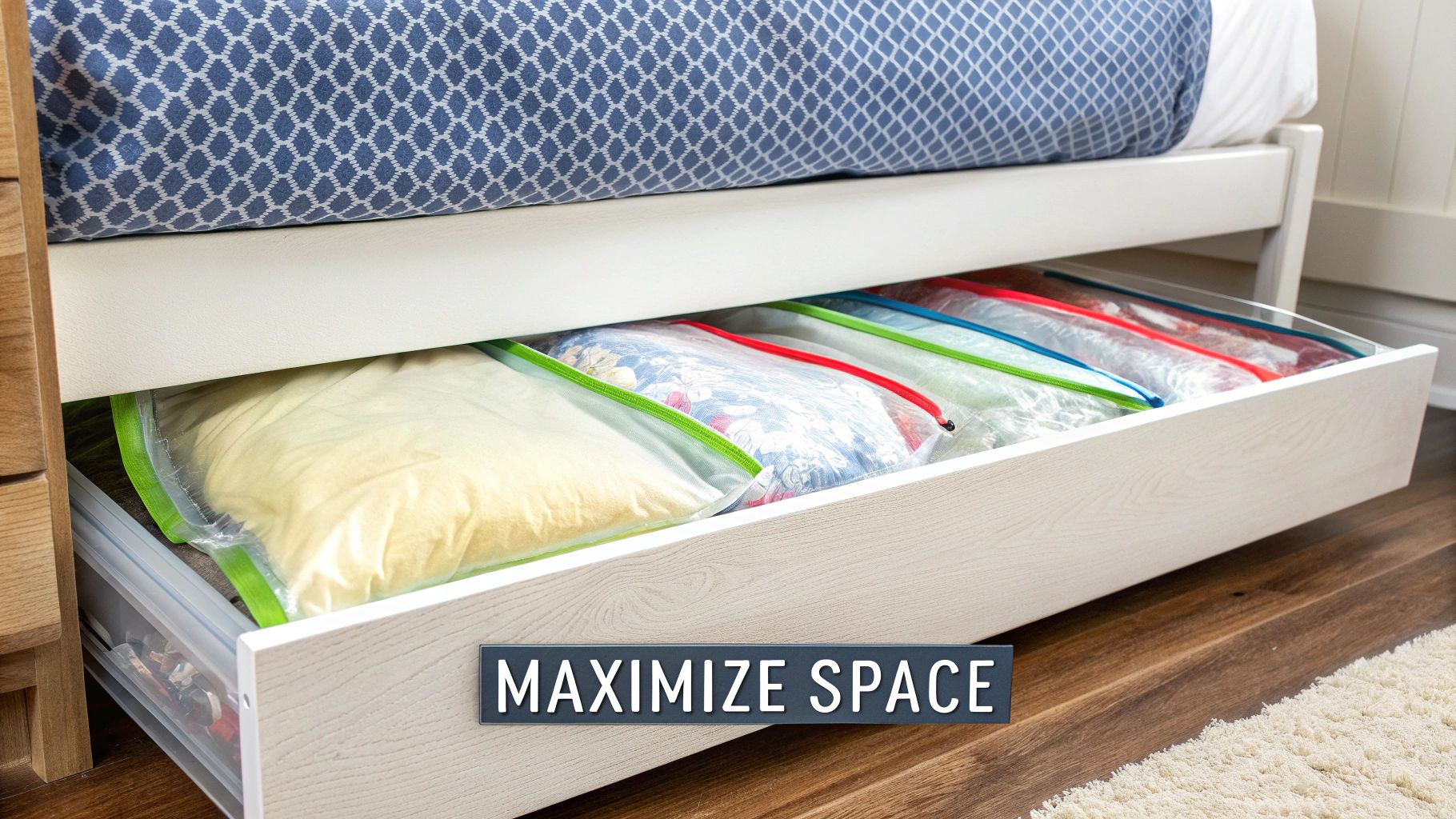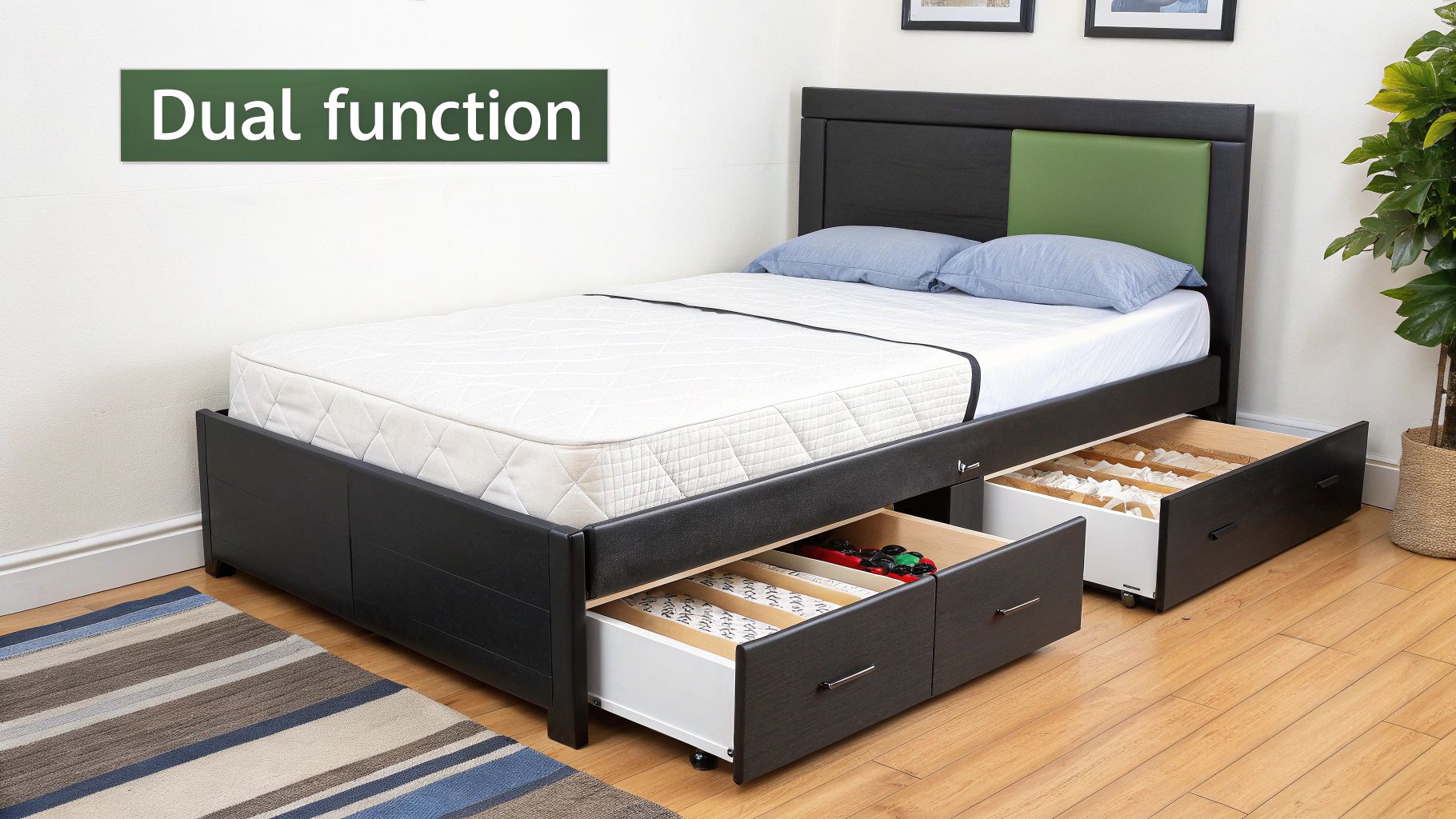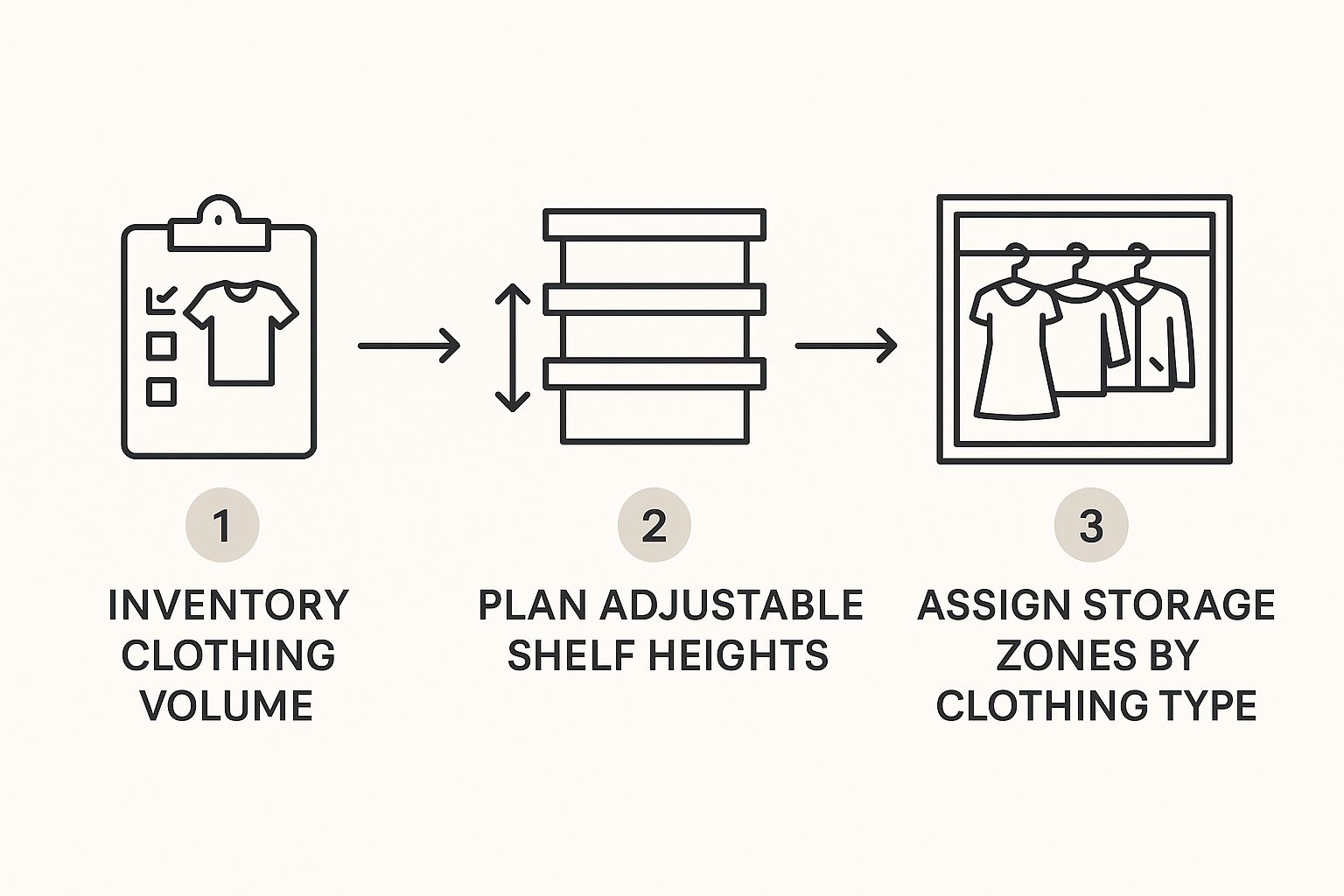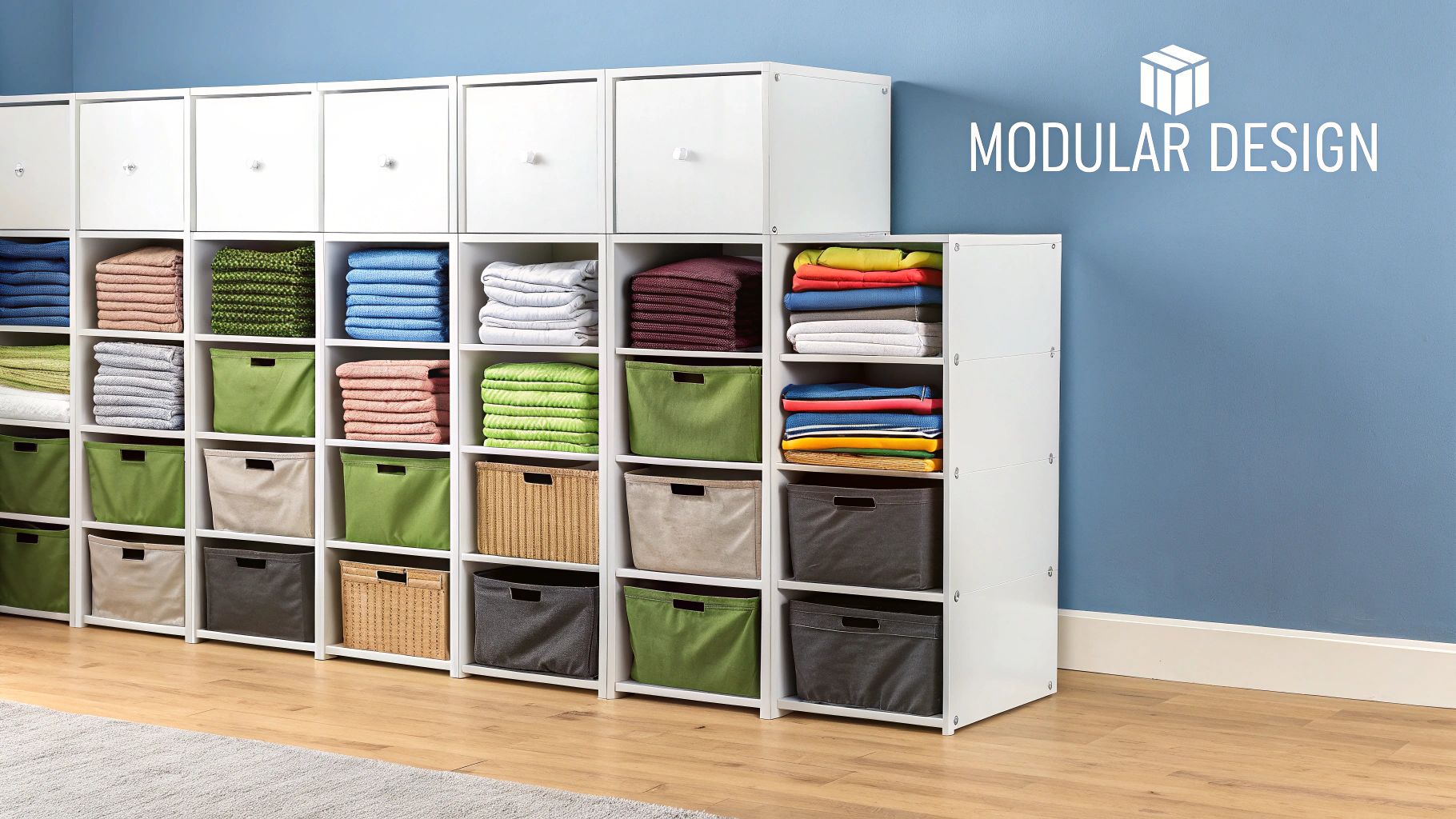Maximize Your Closet with Space Saving Clothing Storage Tips

Before you even think about buying a single new hanger or bin, the real secret to effective space saving clothing storage is taking a hard look at what you already own. It's about organizing the clothes you actually have and love, not just finding clever ways to cram more stuff into an overstuffed closet.
Why Most Closet Organization Attempts Fail

Let’s be honest for a second. We’ve all been there: you spend a whole weekend organizing your closet, only to find it’s a chaotic mess again a few weeks later. If that sounds familiar, you're not alone, and it's not because you didn't try hard enough. The problem is usually starting in the wrong place.
The first instinct is often to rush to the store for more containers and specialty hangers, thinking they'll magically solve the problem. But this approach usually backfires because you're just managing the clutter, not getting rid of it. You just end up with a slightly tidier, but still overwhelming, closet full of clothes.
The Foundational Step You Cannot Skip
For truly lasting space saving clothing storage, you have to start with a practical, no-guilt closet decluttering session. This is where you reclaim your space before you even start organizing. It’s all about making a conscious decision about every single item in your wardrobe.
Think of your closet like a box—it has a fixed capacity. Anything that doesn't fit comfortably inside needs a second look. This simple mindset forces you to be realistic about how much space you actually have.
The real goal isn’t to fit more stuff into your closet. It's to make it effortless to find and enjoy the clothes you genuinely love wearing. Decluttering is the non-negotiable first move.
Start by sorting everything into three simple piles: keep, store, and donate. This process helps you build a curated wardrobe that fits your life and your closet right now.
- Keep: These are the clothes you reach for all the time and feel great in. They’ve earned their spot in the closet.
- Store: This pile is for off-season items (like heavy winter coats) or sentimental pieces you want to hang onto but don't need in your daily closet.
- Donate/Sell: It's time to be honest. If it doesn't fit, isn't your style anymore, or you haven't worn it in over a year, let it go.
Taking this crucial first step ensures you're building a closet organization system for the clothes you actually use. It makes every other tip you follow from here on out so much more powerful.
Choosing the Right Storage Tools for Your Closet

Once the decluttering is done, it's time to equip your closet with the right tools. Walking into a home goods store can be overwhelming—aisles and aisles of bins, dividers, and organizers. The secret to smart space saving clothing storage isn't buying one of everything; it's about making a few strategic investments that solve your biggest closet headaches.
Forget those generic plastic bins for a moment and think about tools that actively multiply your closet space. Cascading hangers are a perfect example of this. They let you hang multiple items vertically, so you can fit five pairs of trousers or a whole collection of camisoles in the space a single hanger used to occupy. This one simple change can instantly free up huge chunks of your closet rod.
Small Upgrades, Big Impact
Sometimes the simplest swaps have the biggest payoff. I always recommend starting with velvet hangers. Their ultra-slim profile takes up way less room on the closet rod than clunky plastic or wood hangers, and the non-slip surface means your silk blouses and strappy dresses actually stay put. It’s a small change that creates a clean, uniform look, making it so much easier to see what you own.
You can also tackle other common closet frustrations with a few clever additions:
- Slim Shelf Dividers: These are fantastic. They just clip onto your closet shelves to create tidy, stable stacks of sweaters or jeans, finally stopping that inevitable avalanche.
- Drawer Organizers: Essential for turning a "junk drawer" in your closet or dresser into a neat, easy-to-navigate grid for socks, underwear, and accessories.
- Over-the-Door Solutions: The back of your closet door is prime real estate that almost always goes to waste. An over-the-door organizer is perfect for shoes, belts, or scarves.
It's no surprise that the demand for these kinds of systems is growing. The global wardrobe market was recently valued at USD 66.31 billion and is expected to keep climbing. This shift is driven by more of us looking for smart, multifunctional storage solutions that work for modern—and often smaller—living spaces. You can read more about the trends in wardrobe and closet systems to see just how popular these upgrades have become.
The real magic happens when you combine tools to create a system that’s customized for your wardrobe. Try using cascading hangers for your pants, slim velvet hangers for your tops, and drawer dividers for your essentials. This creates a complete closet organization system. For more ideas, check out our guide on how to store hangers properly.
Essential vs. Optional Closet Organization Tools
To help you prioritize, here’s a quick-reference guide to which space-saving tools will deliver the biggest impact for your closet and budget. Focus on the essentials first to see the most dramatic results.
| Tool Type | Primary Benefit | Best For | Priority Level |
|---|---|---|---|
| Cascading Hangers | Vertical space multiplication | Pants, skirts, camisoles, outfits | Essential |
| Slim Velvet Hangers | Maximizing rod space, non-slip | Blouses, dresses, delicate tops | Essential |
| Drawer Dividers | Compartmentalizing small items | Socks, underwear, belts, accessories | High |
| Shelf Dividers | Creating stable, neat stacks | Sweaters, folded jeans, linens | High |
| Over-the-Door Organizer | Utilizing unused vertical space | Shoes, scarves, hats, bags | Optional |
| Fabric Storage Bins | Storing off-season or bulky items | Seasonal clothing, extra bedding | Optional |
Start with the "Essential" and "High" priority items, and you'll be amazed at how quickly you can transform a cramped closet into a functional, organized space. The optional tools are great add-ons once you have the core system in place.
Bringing Your New Closet System to Life
Okay, your wardrobe is decluttered, and you've got your new hangers ready to go. Now for the fun part: the actual closet transformation. This is where we stop planning and start building a closet system that genuinely makes your life easier. We're not just stuffing things back in; we're creating an intentional space that streamlines your daily routine.
A core strategy that professional organizers swear by is closet zoning. It sounds fancy, but it's simple: give every category of clothing a designated "home" within your closet. Think of it like your favorite grocery store—you know exactly where the milk is and where to find the bread. Your closet can be that intuitive, too.
This image gives you a great visual roadmap for planning out those zones.

As you can see, smart closet organization is all about knowing what you have, planning the layout, and then giving every single item a logical spot.
Creating Your Closet Zones
First things first, get everything out and group like with like. All your work shirts go in one pile, your casual tees in another, your trousers in a third. Laying it all out gives you a clear visual of just how much you have in each category, which is absolutely essential for mapping out your closet space.
Now, you can start building out your zones.
- Workwear Zone: Keep all your professional clothes together. This is a perfect place for those cascading hangers—hang all your work trousers in one compact spot to instantly free up a huge chunk of your closet rod.
- Casual & Weekend Wear: This is home base for your go-to jeans, t-shirts, and sweaters. A quick tip: avoid hanging heavy knitwear, as it can create those annoying shoulder bumps. Fold them neatly on a shelf instead.
- Special Occasion & Seasonal Items: Formal gowns, tuxedos, or that heavy winter parka you only need for three months? These don't need to occupy prime real estate. Move them to a higher shelf or to the back of the closet so your daily-wear items are front and center.
The best closet systems are the ones designed around your actual life. If you're in gym clothes every morning, make them the easiest thing to grab. The more accessible something is, the more likely you are to put it back where it belongs, keeping the whole system from falling apart.
Go Vertical and Multiply Your Space
With your zones mapped out, it's time to put your MORALVE hangers to work. This is where the magic really happens. Instead of five blouses eating up a foot of rod space, you can hang them vertically in the same footprint as a single, traditional hanger. It’s a simple move that can instantly multiply your usable closet space.
For instance, try dedicating one small section of your closet rod just to trousers. Using space-saving pant hangers, a whole week's worth of options can fit into just a few inches. Imagine that! Do the same for your skirts, blouses, and shirts within their designated zones.
This doesn't just save an incredible amount of room; it also keeps outfit components grouped together, which can be a lifesaver on busy mornings. Suddenly, you've got all this clear floor space, too—the perfect spot to finally tackle your shoe situation. If you need some inspiration there, check out our guide on how to organize shoes in a closet.
Unlocking Hidden Storage in Your Closet

So you've done a big closet clean-out, but does it still feel a little cramped? I've been there. The real game-changer in space saving clothing storage is learning to spot the hidden opportunities in your closet—the nooks and crannies you’ve been ignoring. We need to think beyond the main hanging rod.
Take the back of your closet door, for instance. It’s a huge, flat, empty surface just waiting to be put to work. A simple over-the-door organizer can instantly give you a spot for scarves, belts, or hats, which means you’ve just freed up an entire drawer.
Thinking from Floor to Ceiling
Now, let’s look at the vertical space in your closet. Glance down at the floor under your hanging clothes. It’s easy for that area to become a chaotic pile of shoes, but it’s actually prime real estate. I’m a big fan of clear, stackable shoe boxes. They keep everything dust-free and let you see exactly what you have, turning that floor jumble into a neat tower of footwear.
The same principle applies way up high. That top closet shelf often becomes a graveyard for things we don't know what to do with. The fix is simple: get some matching bins, label them clearly, and use them to store out-of-season items or things you don't need every day. No more mystery boxes or avalanches when you're trying to grab a single sweater.
It's not just us—everyone is looking for smarter storage. The closet organizers market was recently valued at about $4.03 billion and is expected to jump to $8.53 billion by 2035. This huge growth is all because more of us are living in smaller spaces and need our storage to work harder. You can read more about this rapidly growing market for space-saving solutions.
Conquering Awkward Layouts
But what if your closet isn't a perfect rectangle? Those weird corners and sloped ceilings can feel impossible to organize, but they're just a puzzle waiting to be solved.
Here are a few tricks I’ve used in tricky closets:
- Tension Rods: Find a narrow, unused vertical gap? Pop in a tension rod. It’s perfect for hanging scarves, ties, or even tank tops on S-hooks.
- Corner Shelving: A few small corner shelves can completely transform a dead zone into a useful spot for folded sweaters or small accessories.
- Wall-Mounted Hooks: Never underestimate a good hook. Use any free patch of wall inside your closet to hang purses, robes, or even lay out your outfit for the next day.
Once you start seeing your closet this way, you’ll find that every inch has a purpose, creating a space that’s not just organized, but truly efficient.
Keeping Your Closet Organized for Good
The true test of any space saving clothing storage system isn't how neat your closet looks right after you’ve finished. It's about whether it stays that way a month down the road. Let's be honest, anyone can create a picture-perfect closet, but keeping it that way requires building simple habits that actually work with your real life. This isn't about chasing perfection; it's about being a little more mindful of your wardrobe.
One of the most effective habits I've seen work is the 'one in, one out' rule. It's a simple but powerful way to stop your closet from slowly creeping back to its overstuffed state. The moment you bring home a new shirt, an old one has to go. This simple transaction keeps your closet at its ideal capacity and makes you think twice about what you're buying.
Building Simple Maintenance Habits
To keep all your hard work from coming undone, try building in a quick weekly reset. I'm not talking about a deep clean—just a 10-minute closet tidy-up. Finally hang up that pile of clothes living on the chair, put your shoes back where they belong, and make sure everything is in its designated closet zone.
It also helps to schedule quick seasonal check-ins. Before summer or winter really kicks into gear, set aside 30 minutes to give your closet a once-over.
- Review Seasonal Items: Did you wear that heavy coat at all last winter? If not, it might be time for it to go.
- Identify Gaps: Before you hit the stores, figure out what you genuinely need. A new pair of shorts? A warmer sweater?
- Perform a Mini-Declutter: Pull out anything that no longer feels like "you" or doesn't fit right anymore.
This proactive mindset is so much easier than facing a massive decluttering project once a year. If you need a little more guidance on this, our article on how to declutter your closet breaks it down beautifully.
Keeping an organized closet is less about discipline and more about creating a simple routine that feels effortless. The goal is to make it easier to put things away than to let them pile up.
It’s clear people are craving more organized living spaces. The global market for wardrobe organizers is valued at around $15 billion and is expected to keep growing as more of us look for efficient ways to manage our homes. You can learn more about the growth of the wardrobe organizer storage market. By adopting these simple habits, you're not just organizing for today—you're setting yourself up for long-term success.
Got Questions? Let's Talk Clothing Storage.
Even with the best game plan, some clothes just refuse to cooperate. Let's tackle a few of those common closet storage headaches I see all the time. Getting these right is the key to truly maximizing your space saving clothing storage and keeping your wardrobe in top shape.
So, what about those giant winter coats that eat up half the closet? The easiest win here is to get them out of sight during the off-season. Once they’re clean, pop them into breathable garment bags and find a new home for them—under the bed, in a guest room closet, anywhere but your prime closet real estate.
Are Vacuum-Sealed Bags Worth the Hype?
I get this question a lot. Those vacuum-sealed bags look like magic, especially for bulky sweaters and puffy jackets, and for short-term storage, they are! They're fantastic for swapping out seasonal clothes for a few months (three to six is a good rule of thumb).
But here’s the catch: they aren't a great long-term solution. When you keep natural fibers like wool or down compressed for years on end, you risk crushing them permanently. They'll lose that fluff and shape you love. If you're storing something delicate or an heirloom piece, always opt for breathable containers that don't squash the life out of the fabric.
My Two Cents: Use vacuum bags for your seasonal swap-out, but not for your forever pieces. You want to save space, not ruin your clothes.
How to Handle Your Delicate and Special Items
Now for the tricky stuff: silk, cashmere, lace, and other delicate fabrics. These need a bit more TLC to avoid a storage disaster in your closet. Here are a few things I always tell people:
- No More Wire Hangers. Period. They are the enemy of nice clothes. They'll stretch, snag, and leave those awful shoulder bumps. Do yourself a favor and switch to padded or slim velvet hangers for your closet.
- Invest in Acid-Free Tissue Paper. For a special gown or that silk dress you love, lay it flat in an archival box. Placing acid-free tissue paper between the folds is a pro-level move to prevent deep creases and yellowing over time.
- Fold Your Heavy Knits. This is non-negotiable, especially for cashmere. Hanging a heavy sweater is a death sentence; its own weight will stretch it into a shapeless mess. Fold them gently and give them a home on a closet shelf.
- Let Them Breathe. Don't jam your delicate pieces together in your closet. Good air circulation is what prevents that musty smell and keeps your favorites fresh and ready to go.
Sorting out these specific storage puzzles is what takes your closet from just "organized" to a truly functional system that actually protects the clothes you've invested in.
Ready to stop fighting with your closet and start winning? It all begins with having the right tools for the job. See for yourself how MORALVE’s innovative space-saving hangers can completely change the game. Explore our collection and start organizing.


Leave a comment